August 13th
The Landing
The city of Dénia is in the hands of the festeros, and in recent days, one could witness how the Moorish and Christian forces measured their strengths with informal parades. It's on the 13th of August when, at the northern breakwater of Dénia, near Punta del Raset, the Moorish forces, led by their captain, carry out the invasion of the city from the sea. In this representation, the leader of the Moorish faction spearheads the landing, while the Christian captain and his troops await in their camp on the coast, armed with artillery and defensive muskets. Before the battle begins, the Moorish captain attempts to reach a peaceful surrender agreement with the Christian captain. This is the moment of discourse or negotiation, where the Moorish ambassador presents gifts to the Christian ambassador, increasing the offer with each Christian refusal; horses, jewels, gold, and more. This reveals the importance of different roles, such as captains, standard-bearers, and especially in this case the ambassadors.
The captains do not directly communicate with each other; instead, they send their ambassadors to negotiate and try to achieve a peaceful agreement. Neither faction is interested in invading the city, which could be captured or ravaged in a hypothetical battle. However, confrontation seems inevitable as the various offers are rejected by a Christian captain confident in his troops stationed on the beach. The climax arrives in the first battle between the two factions, where the Moors overcome Christian resistance on the beach in a fierce struggle that ends with the surrender of the latter. The signing of the truce symbolizes the Moors' takeover of the city.
The Truce
The Moorish faction has won the first theatrical battle of the festivities on the beach of the northern breakwater of the port. To prevent further bloodshed, resolve the conflict, and achieve an agreement for peaceful coexistence between the Christian population and the newly arrived Moors, it is decided to sign a truce. In this truce, both factions will share Dénia under Moorish authority. As the festivities progress, the degradation of this coexistence is shown, and the Christian willingness to reclaim the territory and lands of Dénia becomes evident. This culminates in the musket battle, where the next showdown between the two sides takes place.
The Crucial Role of FEMMIC in the Festivities
The theatrical representation of historical events has a long tradition in our region. Specifically, with the Moors and Christians Festivities, dating back to the 16th century, Alicante was known for its skills in recreating naval battles and castle sieges. Both religious and secular events involved the dramatization of religious or historical moments, engaging the population and, in some cases, hiring professionals to perform such representations.
Therefore, it's not surprising that the most significant scenes of the Moors and Christians Festivities follow a predetermined script, executed by actors with meticulous staging, with active involvement and collaboration from the filaes. These scenes, including The Disembarkation and the subsequent Truce on August 13th, along with the Musket Battle and the Miracle of the Fog on August 16th, are under the direct responsibility of the Federation of Moors and Christians of Dénia (FEMMICC). The Federation's crucial role lies in funding such spectacular scenes as well as providing coherence and continuity to the celebration through a comprehensive festival script and preserving the narrative of these significant scenes. This script has been integrated into the Federation's statutes since its foundation, ensuring the consistency and longevity of the Festivity. Consequently, FEMMICC has a budget to finance various performances and scenes. Although the script sets the rhythm and history of the Festival, each year's representation and staging hold multiple surprises and emotions.


